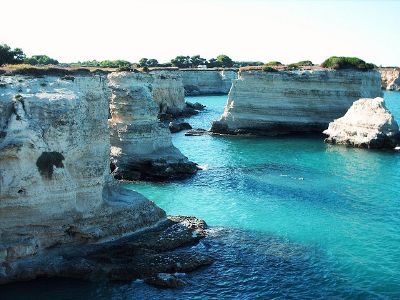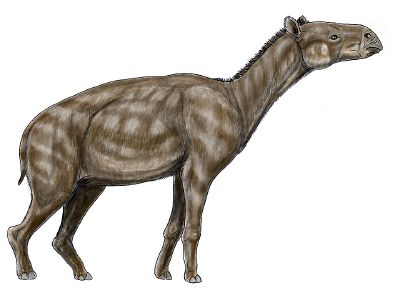Cenozoic
| Phanerozoic eon (542 mya - present) | ||
|---|---|---|
| Paleozoic era | Mesozoic era | Cenozoic era |
The Cenozoic (from the Greek kainos meaning "new" and zoe meaning "life") era is an interval of about 65 million years defined on the geologic timescale as spanning roughly from 65 million years ago (mya) to the present and ongoing into the foreseeable future. The Cenozoic era began after the Cretaceous-Tertiary extinction event at the end of the Cretaceous period that marked the demise of the last dinosaurs and the end of the Mesozoic era.
The fauna and geology of Cenozoic era up to today are vastly different than those of the Mesozoic era, which nonetheless set the stage and foundation for today's fauna and geology. The preceding Mesozoic era has been called the "Age of Dinosaurs," while the present era is sometimes referred to as the "Age of Mammals."
The Cenozoic era is divided into two periods, the Paleogene and Neogene, and they in turn are divided into epochs. The Paleogene period comprises the Paleocene, Eocene, and Oligocene epochs, and the Neogene period comprises the Miocene, Pliocene, Pleistocene, and Holocene epochs, the last of which is ongoing.
Historically, the Cenozoic era has been divided into periods (or sub-eras) named the Tertiary (Paleocene, Eocene, Oligocene, Miocene, and Pliocene epochs) and the Quaternary (Pleistocene and Holocene epochs). However, the International Commission on Stratigraphy (ICS) has decided to stop endorsing the terms Quaternary and Tertiary as part of the formal nomenclature, making the Paleogene and Neogene periods the official nomenclature of the ICS.
| Cenozoic era (65-0 mya) | |
|---|---|
| Paleogene | Neogene Quaternary |
Geology of the Cenozoic
Geologically, the Cenozoic is the era when the continents moved into their current positions. Australia-New Guinea, having split from Pangea during the early Cretaceous, drifted north and, eventually, collided with Southeast Asia; Antarctica moved into its current position over the South Pole; the Atlantic Ocean widened and, later in the era (2.8 million years ago), South America became attached to North America with the isthmus of Panama.
India collided with Asia creating the Himalayas; Arabia collided with Eurasia, closing the Tethys Ocean and creating the Zagros Mountains, around (Allen and Armstrong 2008).
The break-up of Gondwana in Late Cretaceous and Cenozoic times led to a shift in the river courses of various large African rivers including the Congo, Niger, Nile, Orange, Limpopo, and Zambezi (Goudie 2005).
Life in the Cenozoic era
The Cretaceous-Tertiary extinction event, known also as the K-T extinction event, occurred about 65.5 million years ago. Approximately 50 percent of all plant and animal families disappeared during this mass extinction, including the non-avian dinosaurs. The most widely accepted current theory for this extinction is that an object from space produced an impact event on Earth.
Early in the Cenozoic, following the K-T extinction event, the planet was dominated by relatively small fauna, including small mammals, birds, reptiles, and amphibians. From a geological perspective, it did not take long for mammals to greatly diversify in the absence of the dinosaurs that had dominated during the Mesozoic (Shupinski et al. 2024).
Birds also diversified rapidly; some flightless birds grew larger than humans. These species are sometimes referred to as "terror birds", and were formidable predators. Mammals came to occupy almost every available niche (both marine and terrestrial), and some also grew very large, attaining sizes not seen in most of today's terrestrial mammals.
During the Cenozoic, mammals proliferated from a few small, simple, generalized forms into a diverse collection of terrestrial, marine, and flying animals, giving this period its other name, the Age of Mammals. The Cenozoic is just as much the age of savannas, the age of co-dependent flowering plants and insects, and the age of birds. Grasses also played a very important role in this era, shaping the evolution of the birds and mammals that fed on them. One group that diversified significantly in the Cenozoic as well were the snakes. Evolving in the Cenozoic, the variety of snakes increased tremendously, resulting in many colubrids, following the evolution of their current primary prey source, the rodents.
In the earlier part of the Cenozoic, the world was dominated by the gastornithid birds, terrestrial crocodylians like Pristichampsus, large sharks such as Otodus, and a handful of primitive large mammal groups like uintatheres, mesonychians, and pantodonts. But as the forests began to recede and the climate began to cool, other mammals took over.
The Cenozoic is full of mammals both strange and familiar, including chalicotheres, creodonts, whales, primates, entelodonts, sabre-toothed cats, mastodons and mammoths, three-toed horses, giant rhinoceros like Paraceratherium, the rhinoceros-like brontotheres, various bizarre groups of mammals from South America, such as the vaguely elephant-like pyrotheres and the dog-like marsupial relatives called borhyaenids and the monotremes and marsupials of Australia.
ReferencesISBN links support NWE through referral fees
- Allen, M.B., and H.A. Armstrong. 2008. Arabia-Eurasia collision and the forcing of mid Cenozoic global cooling. Palaeogeography, Palaeoclimatology, Palaeoecology 265 (1–2): 52–58.
- Goudie, A.S. 2005. The drainage of Africa since the Cretaceous. Geomorphology 67 (3–4): 437–456.
- London Natural History Museum. 2017. British Caenozoic Fossils (Tertiary and Quaternary). Natural History Museum, London. ISBN 978-0565093051
- Raymond, A., and C. Metz. 2004. Ice and its consequences: Glaciation in the Ordovician, Late Devonian, Pennsylvanian-Permian and Cenozoic compared. Journal of Geology 112:655-670.
- Redfern, R. 2001. Origins: The Evolution of Continents, Oceans and Life. Norman, OK: University of Oklahoma Press. ISBN 0806133597
- Shupinski, A.B., P.J. Wagner, F.A. Smith, and S.K. Lyons. 2024. Unique functional diversity during early Cenozoic mammal radiation of North America. Proceedings of the Royal Society B: Biological Sciences. 291.
External links
All links retrieved June 6, 2025.
- The Cenozoic Era University of California Museum of Paleontology
- Cenozoic era: Facts about climate, animals & plants Live Science
- Cenozoic Era National Park Service
- Cenozoic Era Paleobiology Virtual Fossil Museum
Credits
New World Encyclopedia writers and editors rewrote and completed the Wikipedia article in accordance with New World Encyclopedia standards. This article abides by terms of the Creative Commons CC-by-sa 3.0 License (CC-by-sa), which may be used and disseminated with proper attribution. Credit is due under the terms of this license that can reference both the New World Encyclopedia contributors and the selfless volunteer contributors of the Wikimedia Foundation. To cite this article click here for a list of acceptable citing formats.The history of earlier contributions by wikipedians is accessible to researchers here:
The history of this article since it was imported to New World Encyclopedia:
Note: Some restrictions may apply to use of individual images which are separately licensed.

